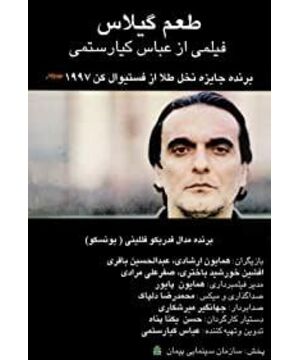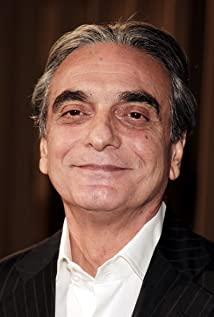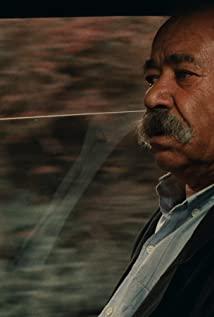The film begins with Griffith and ends with Abbas
—Jean-Luc-
Godardbazin once asked a deafening question: “What is film?” Abbas used his The work answers: Cinema is the path to reality.
Thanks to his other dual identities - photographer and poet, Abbas's film style is difficult to attribute to any one genre, with poetic narration and thinking, and photography-like precision in detail Record.
The styles of his various film works are also different. In "The Taste of Cherry", Abbas changed his previous style of showing the beauty of life from the perspective of innocence, and told a story about truth and death story.
The film begins with the shot of the protagonist Buddy driving (picture 1), the camera is placed in the co-pilot position, and the camera is aimed at Buddy who is looking around, with a group of people walking on the streets of Tehran in the background. Here, the audience's perspective is the opposite of Buddy's. Abbas immediately grabs the audience's attention with a pre-emptive gesture: What is Buddy looking for? Another interesting point is that the car frame builds the frame of the shot, combined with the development of the subsequent story, it is difficult not to conjure up a metaphor: there is an insurmountable barrier between Buddy's world and the society outside, and the noisy The voice-over of , forms a series of ambiguous utterances of ambiguous meaning, symbolizing the incommunicability of a language (this metaphor is expressed more clearly in the film).
Then the camera cuts to the opposite direction (Figure 2). At this time, the audience's perspective coincides with Buddy's. If the audience just saw a neutral Tehran, then the Tehran in Buddy's perspective is It's a city full of homeless people. This repeated conversion of perspectives constitutes a repetition of the narrative structure of the entire film. The audience constantly switches between the perspectives of Buddy and the passengers, completely subverting Abbas’s usual long-shot style, with a series of switching frequencies. The extremely high front and back shots force the audience into the situation of Buddy and the passengers, and let all the elements used to describe Buddy's situation appear on the table, as if the questions and materials are laid out on the table at the same time, forcing the audience from Buddy's point of view. To think - live or die - and think from the passenger's point of view: how to convince others (or yourself) that life is good.
Another interesting point is that the eyes of the unemployed on the street are all looking directly at the camera. Generally speaking, such a design is a taboo. However, here, the eyes of passersby are subtly transformed into a kind of stare, a kind of authenticity. 's gaze.
Buddy drove through a clearing and saw two children playing in the scrapped car shell (Picture 3). This implies a kind of opposition: the dilapidation represented by the scrapped car and the vitality represented by the child (life Meaningful or meaningless opposition?).
Then Buddy drove the car gradually out of the city and stopped in a desert. Here, for about half a minute, Buddy stared out of the window in such a posture, and the voiceover was a man playing phone, but never showed up. The use of similar voiceovers is a major feature of the film. Abbas once said: "For me, the sound is very important, more important than the picture. What we get through photography is at best a flat image. The sound produces the picture. Vertical depth, which is the third dimension of the picture." Then Buddy turned the car around, and we finally saw the person who called just now (Figure 5). At this time, Buddy offered to help this man, but was rudely refused. Abbas threw the first suspense: What does Buddy want to do?
Then Buddy met a scavenger (picture 6). Buddy asked him, "Do you know what the words on your clothes mean?" The scavenger was silent. This is probably a metaphor that we live in this world but have little understanding of this world. Most people are confused and imprisoned in a small space by life. They don’t want to go or think about their situation. Even being horrified by the occasional glimpse of the outside world, like the scavenger who turned down Buddy's high pay just because he thought he only knew how to pick up plastic bags.
Buddy drove back to the city and met a young soldier (Picture 7). Buddy spoke with him and reminisced about his old military life. It seems rather embarrassing that a man who seeks death recollects the life of the army in a tone of enthusiasm, while a soldier in the middle does not respond to it. Abbas seems to be trying to describe the complexity and incomprehension of the human heart with this completely opposite thing: contradictions and opposites are everywhere, and this is the source of the uncertainty of life.
Buddy drove the soldiers to the barren hills on the outskirts of Tehran and told them what to do. When the soldiers learned that Buddy wanted him to bury himself, he chose to run away. A soldier who kills as a profession is afraid to bury a dead man, because he goes to the battlefield to kill the enemy just to carry out orders, as if killing the enemy is separate from his nature and independent, so he has an excuse to wrap himself in the In a state of peace of mind; and Buddy's request exposed him to the fork in the road that life gave him, he had the freedom to choose, but he was afraid, because at this time he could no longer find a way to make himself A convincing excuse, whether it is rejection or acceptance, so he can only choose to escape (its mental state is exactly the same as Buddy's mentality when he finally faces the problem of life and death, which will be analyzed below, but here Abbas gives clear answer). He flew all the way back to Tehran from the mound. At this time, we were shocked. The mound and Tehran foreshadowed two completely different worlds. The mound represented Buddy - or everyone's inner world. There is a kind of grandeur; Tehran represents the mundane world, noisy but dynamic: so we understand why Buddy has been driving his car between the mound and Tehran constantly, because this back and forth represents Buddy The swing of the heart - between life and death, between loneliness and trouble, between speech and ineffable.
If you carefully observe the structure of this film, you will find that the entire film has been repeating the structure of "close-up front and back - long-range - close-up front and back - long-term view", which implies a kind of "thinking-experience" -Thinking-Experience" life experience, as shown in Figure 9, Buddy's car was stuck on the side of the road, and a group of people who did not know where they came from immediately surrounded him. Dee's car was pushed back into the middle of the road. This slightly surrealistic plot is like an occasional adventure that everyone encounters in life. It rolls around like a whirlwind. It seems that a little bit has changed, but it is impossible to notice the specific change.
Here again, the use of the iconic voice-over appears. From the dialogue, it can be seen that Buddy is talking to a person who is looking at a concrete tower (Picture 10). Buddy's sight goes beyond the frame of the picture, creating a tension from the "third dimension".
A seminary student took the seat of the co-pilot (picture 11), when Buddy finally fully explained his plan, and the whole film was halfway through. The students tried to persuade Buddy to give up the idea of suicide based on religious teachings, but Buddy told him: "You can't understand how I feel." Then the student invited Buddy to try his friend's fried eggs, trying to awaken Buddy's yearning for a better life, but Buddy refused. Note that the old man who told the story later said that he gave up suicide because of the delicious mulberry fruit. Why did the same method have different effects? Here Abbas seems to be talking about the incommunicability between people, or a lack of language orientation: language loses its power and is replaced by the experience of the situation. Here, Abbas formally introduces a philosophical proposition into the film. I think this proposition is also the core of the whole film, that is, experience. The experience of different possibilities of life constitutes each person's unique world view. This kind of ideological shock is not only aimed at Buddy (through the old man's narration, he entered the situation the old man had experienced and was shaken by suicide), but also aimed at the audience. This proposition is integrated into every shot of the film, and then we can realize the charm of the whole film: all those seemingly trivial and meaningless shots symbolize different experiences in life, and some experiences are not Leaving no trace, some experiences make us feel the beauty or cruelty of the world, but no matter what kind of experience they are, they subtly shape our personality, our thinking and our perception of things. Abbas once described his work as a "poetic film", that is, a film is made up of poetic fragments connected together, there is a connection between the films, but splicing them in any order will It doesn't matter, it may have unexpected effects: as the experience mentioned above, there is a connection between different experiences, but the combination of different experiences will produce new experiences, the focus is not on the final answer, but The process of experience, a wonderful experience produced by arrangement and combination, an ambiguous and hazy beauty brought about by the uncertainty of life.
The pouring sand rolled over Buddy's shadow (Picture 12), and Buddy faced the workers' question of "What are you doing here?" in the rolling sand and remained silent (Picture 13). The growing desire for life in Buddy's heart.
An old man gets into Buddy's car and the story begins to change, as Buddy retreats from the role of the speaker to the role of the listener, while at the same time following the old man's instructions and driving down a road he has never driven before (Fig. 14), all of which heralded Buddy's psychological changes at this time. The story told by the old man also illustrates the point of view that Abbas wants to express: the uncertainty and multiple choices of life mean that the path of life depends more on the adjustment of the self-consciousness rather than the limitations of the objective world.
To a certain extent, this change of mentality of the old man is in line with Sartre's philosophy, that is, he has found a reason (value) for himself to continue to exist: delicious mulberry fruit, magnificent sunrise, The innocence of a child all indicates that there is still something in this world worthy of his appreciation. The change of Buddy's mentality is in line with the "anxiety" and "dizziness" proposed by Sartre: Buddy had an immersive experience through the old man's narration. He felt the mood of the old man when he gave up suicide. At this time He is essentially free, but it is this freedom (or the right to choose freely) that brings about the dilemma of choice: whether to commit suicide or not? And this difficulty will cause anxiety and dizziness, so he will immediately turn around to look for the old man after parting with the old man, and say to him: "Please hit me with two stones to make sure I am not asleep." (Fig. 15). It is this anxiety and vertigo that leaves the biggest suspense at the end of the film: Did Buddy commit suicide? I don't know, and neither does Abbas, because everyone has their own answers in their hearts.
As shown in Figure 16, Buddy sits under a cherry tree and looks into the distance. There is brightly lit Tehran, but beneath him are desolate mounds: life or death? A tough choice indeed.
At the end of the film is a clip showing Abbas shooting "The Taste of Cherry", Buddy walks past the camera (Picture 17). This passage completely blurs the line between true and false, and we can't tell which Buddy is the real one. As with all the weird things that happen in life, sometimes we really can't tell if they are hallucinations or real.
The whole film slowly guides us to its core idea with the attitude of a guide, just like a train running through a tunnel constantly. In the process of approaching the truth, the camera will show us different scenery like poetry, but it is also very different. It's not so real, it's like a wisp of smoke that you can clearly see but can't hold in your hand. It changes every moment, and every moment has a new understanding. Different perspectives and different life experiences will make people feel in this book. There are different emotions in the movie. This is in line with Abbas's consistent thinking: "We can never grasp the truth, we can only keep approaching it."
The film does not give a clear answer through an open ending, which is not only a consistent extension of the above ideas, but also a clever way of leaving blank: no one knows what kind of scenery is at the end of the tunnel, and everything needs to be experienced by the audience. to excavate. As Abbas said: "The director should not think of himself as a salesperson... All films should be open-ended, asking questions, leaving the audience room for imagination and forming their own opinions".
I think that's why Godard said "The film ends with Abbas", because he gave the film infinite extension space and gave us infinite imagination space. When other directors take beautiful scenery photos on our faces, When he talked about the beauty of life, Abbas said gently to us: Go, child, get out of the house, observe and experience the outside world!
View more about Taste of Cherry reviews











